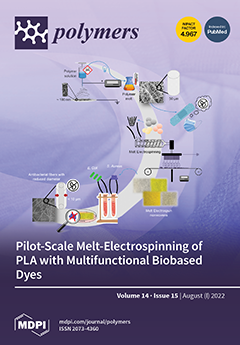Experimental Investigation on the Performance of SBS-Modified Asphalt Waterproofing Membrane by Thermo-Oxidative Aging and Freeze–Thaw Cycle
IF 4.7
3区 工程技术
Q1 POLYMER SCIENCE
引用次数: 0
Abstract
With global warming in recent years, extreme weather conditions have increased in frequency and intensity, exacerbating the challenges for waterproofing materials. The current stages of SBS asphalt waterproofing membrane aging research mainly focus on the raw materials and modifiers in a single factor; multifactor-coupled aging research is less studied. This study focused on the coupled aging characteristics of SBS-modified asphalt waterproofing membranes, aiming to reveal the mechanism of its influence on the material’s performance under the environmental effects of high temperature and freeze–thaw. Through the accelerated aging test, we simulated the environmental conditions of high temperature in summer and freeze–thaw in winter to observe the mechanical properties of waterproofing membranes, low-temperature flexibility, and apparent phenomena. Then, Fourier transform infrared spectroscopy (FTIR) evaluated the performance and chemical structure of SBS-modified asphalt waterproofing membranes after aging by the coupled aging of the thermo-oxidative freeze–thaw cycle. The results showed that the low-temperature flexibility of the waterproofing membranes was significantly reduced after the coupled aging effect, and, at the same time, their tensile strength was also reduced. However, despite the tensile properties being impaired, the membrane maintained good ductility, and its elongation at break did not fall below 47%.热氧化老化和冻融循环对 SBS 改性沥青防水卷材性能的实验研究
近年来,随着全球气候变暖,极端天气出现的频率和强度不断增加,加剧了对防水材料的挑战。现阶段SBS沥青防水卷材的老化研究主要集中在原材料和改性剂的单一因素上,多因素耦合老化研究较少。本研究主要关注SBS改性沥青防水卷材的耦合老化特性,旨在揭示其在高温、冻融等环境作用下对材料性能的影响机理。通过加速老化试验,模拟夏季高温和冬季冻融的环境条件,观察防水卷材的力学性能、低温柔性和表观现象。然后,通过傅立叶变换红外光谱(FTIR)评估了SBS改性沥青防水卷材在热氧化冻融循环耦合老化后的性能和化学结构。结果表明,经过耦合老化作用后,防水卷材的低温柔韧性明显降低,同时,其抗拉强度也有所降低。不过,尽管拉伸性能受损,防水卷材仍保持了良好的延展性,其断裂伸长率不低于 47%。
本文章由计算机程序翻译,如有差异,请以英文原文为准。
求助全文
约1分钟内获得全文
求助全文
来源期刊

Polymers
POLYMER SCIENCE-
CiteScore
8.00
自引率
16.00%
发文量
4697
审稿时长
1.3 months
期刊介绍:
Polymers (ISSN 2073-4360) is an international, open access journal of polymer science. It publishes research papers, short communications and review papers. Our aim is to encourage scientists to publish their experimental and theoretical results in as much detail as possible. Therefore, there is no restriction on the length of the papers. The full experimental details must be provided so that the results can be reproduced. Polymers provides an interdisciplinary forum for publishing papers which advance the fields of (i) polymerization methods, (ii) theory, simulation, and modeling, (iii) understanding of new physical phenomena, (iv) advances in characterization techniques, and (v) harnessing of self-assembly and biological strategies for producing complex multifunctional structures.
 求助内容:
求助内容: 应助结果提醒方式:
应助结果提醒方式:


